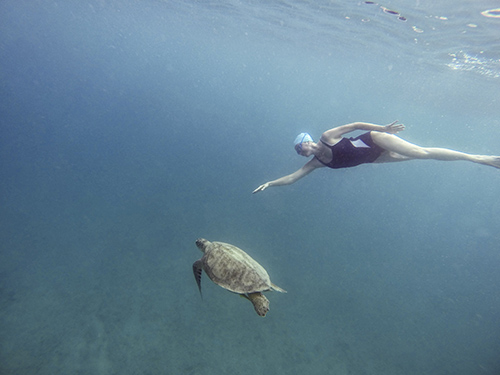
Emphasize The Exhale

To improve your capabilities and comfort with breathing, here are a few more encouragements and ideas for you…
Make sure you emphasize the exhale in your non-breathing moments of the stroke. Contrary to instincts, this urgency and ‘breathlessness’ you feel while swimming is likely not a hunger for more O2. What your body is desperate for is the removal of CO2 from the blood stream.
If you are holding your breath, you are going to suffer. It is stressful for the body. Practice releasing a small, steady stream of bubbles from your nose the entire time your face is underwater.

Less CO2, Not More O2
I learned this from breath-holding activities – when you inhale then hold breath underwater, when you start to feel the urge to come to the surface to breathe, just start softly exhaling. The release of carbon dioxide (CO2) will calm those alarms and buy you more time before you actually need to take in more oxygen (O2).
In conjunction with this emphasis on the exhale, practice a ‘quick sip of air’ on the inhale. Common instinct is to take an equally long and drawn-out inhale to match the long steady exhale, but we don’t need to. In easy to moderate exertion, we don’t need more O2, we just need to get rid of more CO2.
Here is what I am coming to understand about respiration: the blood, even at moderate to high exertion, has more than enough O2 in it for our needs. We only use a part of it and actually expel quite a bit on each exhale along with CO2.
Fun Fact: rescue breathing works on this principle – normal air contains about 20% oxygen. The air you exhale contains about 14% oxygen. This is the reason CPR works – you have excess O2 coming out of your blood, out of your lungs and it is enough to keep another person alive. That means you have more than enough O2 in your blood to keep you going for quite a while without having to replenish it 100% on every breath.
So, what our breathlessness likely indicates is that we need to expel CO2 more aggressively, not take in O2 more aggressively. When we rid the blood of CO2 this triggers the muscles to pull more O2 from the blood. Common breathlessness in swimming is not a problem of too little O2 but too much CO2 in the blood.
Training To Be Comfortable With Discomfort
This idea needs to be joined with another – when under athletic exertion you will feel signals of discomfort because the cardio-vascular system is working in a different energy-processing mode. When that discomfort start to grow initially, it may compel you to stop at the wall soon – you experience this as a high heart rate and breathlessness. Why are you stopping? Likely because some part of your brain is afraid that this discomfort is going to get worse and worse until you pass out.
Actually, you may be surprised to find that the discomfort rises only to a moderate level and then it doesn’t get any worse. You may find that, though it is initially unfamiliar and therefore uncomfortable, you could actually keep swimming in that discomfort and go much further than you imagine. Your body would be OK. In fact, after some time (like 5 to 15 minutes) your body would adapt to it and the discomfort would go down, if only you would train in that zone a little while longer. After some weeks of training this way, you may find that those alarms no longer go off and you have much less negative association with those sensations – they are no longer labeled as ‘uncomfortable’; they are just normal now. Practice this longer and you may even look forward to it! The sensations would then be associated with the flow and fitness you gain in each practice.
A Dry-Land Exercise
Here is something you can do any time any where. I especially like to do this as a self-calming exercise.
Any time you think of it, simply make a steady and complete exhale and then hold your breath for a while with the lungs nearly empty. It could be just a couple seconds or many more. Just wait there for a moment – you may pay attention to the soft beating of your own heart in some parts of the body. Observe the sensations in your lungs when they are quite empty. Observe the changes in sensations in your body and breathing muscles as the second tick by. Get familiar with this sequence of changes and sensations. See what happens when you hold just a little longer past that initial discomfort. What were before alarms that made your feel desperation can become mere sensory information that you handle mindfully. These no longer need to be labeled as ‘uncomfortable’.
When you take your first inhale try to make it soft as normal – resist the urge to compensate for the extra time holding your breath. Breath softly and normally after each breath hold.
This little exercise is one way you can encourage your body’s tolerance and comfort when respiration is limited by those extra breath holds you take during a flip turn, and for breathing within the constraints of your stroke cycle.
~ ~ ~
